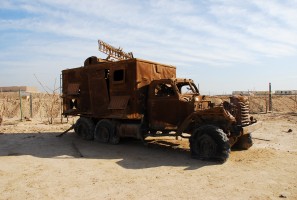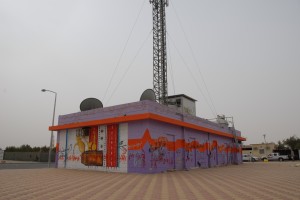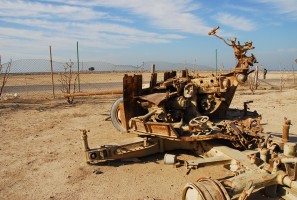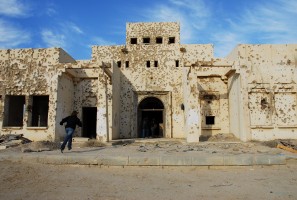Affective Mediations of Violence

Failaka 2012. War truck left as part of a museum exhibit. Photo courtesy Conerly Casey
The 1990 Iraqi invasion of Kuwait and seven-month occupation led to highly mediated, emotionally charged ideas, images and sounds of war?affective mediations of violence that continue to circulate. Less accessible to media publics is a Harvard School of Public Health (2005) finding that Kuwaitis, aged 50 years or older, who had remained in Kuwait for all or part of the occupation, were at 20?30% greater risk of mortality than those who left the country. John Evans (Evans 2008; HSPH 2005), director of a Harvard School of Public Health assessment of post-invasion Kuwait, suggested that smoke from more than 700 oil fires burning from January to November of 1991 contributed to these higher mortality rates, though not in ways sufficient to cause the observed increases. After screening for ?other contaminants?such as volatile organic compounds, polycyclic aromatic hydrocarbons and metals from the oil lakes and marine oil spills; and depleted uranium,? the HSPH (2005) researchers concluded that ?exposures to these compounds were unlikely to lead to appreciable risks to public health.? The HSPH group, collaborating with Professor Jaafar Behbehani (Kuwait University Faculty of Medicine) and his colleagues at Kuwait?s Al-Riggae Specialised Centre (Hammadi 1994), proposed instead that a combination of oil smoke and PTSD would explain the higher prevalence of mortality in the 14 years since independence (HSPH 2005). Oil smoke, PTSD and depression became dominant lenses through which researchers and Kuwaiti government and private health care providers, understood, structured and treated war traumas (Abdel-Khalek 1996, 1997; Abdullatif 1995; Al-Naser et al 2000; Brain 1998; Dockery 2009; Evans 2008; Hadi and Llabre 1998; Hammadi 1994; Llabre and Hadi 1997; Nader et al 1993).

Communications tower in Al-Jahra, Kuwait, a site of intense fighting during the 1990 Iraqi invasion. Photo courtesy Conerly Casey
However useful, this body of scholarship directed attention away from the moral appraisals of the Iraqi invasion that continue to shape the selection, use and interpretation of remembrances of violence, collaborative and relational remembering, the various forms of media that situate and inscribe violence, and affective amplifications of past violence by subsequent events and interactions (Casey forthcoming). It also did little to quell my concern about the large numbers of students at the American University of Kuwait and their and age-mates employed in government and private businesses, diagnosed with tumors, gastrointestinal and reproductive problems, tension and severe headaches?a constellation of symptoms that may result from exposure to toxins.
A thorough review of the research on war contamination in Kuwait, revealed no literature that addressed chronic, low-level, incremental exposures to the combination of known war pollutants (and other sources of pollution) in children and young adults. Over the three years I spent with young Kuwaitis (2006?09), the dearth of information about chronic, low level exposures to war pollutants pressed me to find other modes of understanding. I began to trace their memories of war in topographical, collaborative and mediated remembering, through ill health and distress, bombed and bullet-ridden homes left standing, talk of families and neighborhoods blown apart by war, of Failaka, a former resort, left abandoned to war artillery and war tours, memories and reenactments of liberation brought forth by the Liberation Tower and War Museum, discussions of war in diwaniyas and families, and in the real-virtual interfaces of the invasion and occupation with contemporary mediated accounts of it. Through a combination of methods?person-centered, semi-structured and informal interviews, participant-observation, a review of print, broadcast and Internet-based media, popular art, poetry, music and literature, I sought to understand Kuwaiti remembering of the 1990 invasion and occupation, in affective sensorial attunements to danger, self-reports of ill health, and in the changing dynamics of self-, self-other, and self-society referencing. My research suggests that remembering the 1990 Iraqi invasion and occupation of Kuwait became increasingly traumatic for young adults in their teenage years, after the start of the 2003 US War in Iraq, with dramatic changes in their self-perceived health and health statuses during this period. Most significantly, Kuwaiti young adults believed their health declines were directly related to emotional, embodied affects of Internet-based media perspectives from youths of neighboring countries, most of whom blamed Kuwaitis for both the 1990 Iraqi invasion and the 2003 US War in Iraq. Young Kuwaitis said the emotional and bodily distress of such media interactions, alongside conflicts with friends and family in Kuwait over the morality of the 2003 US War in Iraq, was so debilitating that they became either obsessed with broadcast and Internet-based media, or completely withdrawn from it.

Failaka bank vault. Photo courtesy Conerly Casey
Affective sensorial and mediated sources of danger reverberating with the 1990 Iraqi invasion of Kuwait and the 2003 US War in Iraq, such as worry over increased US and Iranian tensions, brought about amplifying waves of conflicted moral appraisal, ambivalence about identity and security, affective responses to parental emotion and to war as the time and space of family closeness and Kuwaiti national cohesion, yet also of abandonment and betrayal, domestic violence and substance abuse. Young Kuwaitis spoke of heightened concern, emanating initially from these two wars, about the environment?natural/contaminated, built/blown apart, social/fractured, and political?structuring narratives of war that condense pre- and post-invasion regional wars and Kuwaiti ill health and social problems, into narrations of the 1990 Iraqi invasion.

Failaka 2012. War artillery left as part of a museum exhibit. Photo courtesy Conerly Casey
This condensation of war memory has, in part, been driven by the PTSD and oil fire framing which trace health problems back to a ?primary wounding? during the 1990 Iraqi invasion, but it also served to unite Kuwaitis, who had vastly different experiences of occupation under Bathist and regular Iraqi Army troops, the former portrayed as brutally violent and morally culpable, while the latter Kuwaitis likened to their own children, Muslim youths forced into military service against their wills. It is important to note that these forms of remembering and narrating are dynamically related to forgetting, to social silencing, andto the materiality of pre- and post-invasion life, those aspects bound by nation and time, such as dead bodies and destroyed infrastructures, and those, boundless, circulating in Internet-based media or blowing in sand, contaminated by war chemicals.

Failaka bank. Photo courtesy Conerly Casey
Remembering and ill health in post-invasion Kuwait, heavily structured by an oil fire and PTSD framework, has primarily been documented in research conducted for the State of Kuwait, and under the auspices of the United Nations Compensation Commission, charged with evaluating Iraq?s liability for harm to Kuwaitis. PTSD and Iraqi liability construct and underpin support for burgeoning psychological services, which have had mixed reviews. Simultaneously, Salafi preaching and anti-sorcery campaigns, held in Kuwaiti educational centers and shopping malls, provide competing interpretations of post-invasion violence and ill health. Psychological and Salafi perspectives now dominant in Kuwaiti discourses of war, obscure and hide alternative rememberings of the 1990 Iraqi invasion and the 2003 US War in Iraq as they articulate with more recent wars and with pre- and post-invasion life in Kuwait, diminishing public discussion and social, political perspectives on suffering and accountability.
Conerly Casey is associate professor of anthropology in the department of sociology and anthropology at the Rochester Institute of Technology. She has research interests in the dynamics of psychocultural and global processes, particularly experiences of violence and amplifications of memory and emotion through media and social networking technologies.
Minka Kelly sex tape Colorado shooting Colorado shooting victims aurora Angie Everhart tom hardy columbine
No comments:
Post a Comment
Note: Only a member of this blog may post a comment.